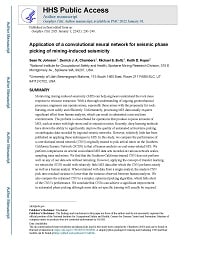Mining Publication: Application of a Convolutional Neural Network for Seismic Phase Picking of Mining-induced Seismicity
Original creation date: January 2022
Authors: S Johnson, D Chambers, M Boltz, KD Koper
Monitoring mining-induced seismicity (MIS) can help engineers understand the rock mass response to resource extraction. With a thorough understanding of ongoing geomechanical processes, engineers can operate mines, especially those mines with the propensity for rock-bursting, more safely and efficiently. Unfortunately, processing MIS data usually requires significant effort from human analysts, which can result in substantial costs and time commitments. The problem is exacerbated for operations that produce copious amounts of MIS, such as mines with high-stress and/or extraction ratios. Recently, deep learning methods have shown the ability to significantly improve the quality of automated arrival-time picking on earthquake data recorded by regional seismic networks. However, relatively little has been published on applying these techniques to MIS. In this study, we compare the performance of a convolutional neural network (CNN) originally trained to pick arrival times on the Southern California Seismic Network (SCSN) to that of human analysts on coal-mine-related MIS. We perform comparisons on several coal-related MIS data sets recorded at various network scales, sampling rates and mines. We find that the Southern-California-trained CNN does not perform well on any of our data sets without retraining. However, applying the concept of transfer learning, we retrain the SCSN model with relatively little MIS data after which the CNN performs nearly as well as a human analyst. When retrained with data from a single analyst, the analyst-CNN pick time residual variance is lower than the variance observed between human analysts. We also compare the retrained CNN to a simpler, optimized picking algorithm, which falls short of the CNN’s performance. We conclude that CNNs can achieve a significant improvement in automated phase picking although some data set-specific training will usually be required. Moreover, initializing training with weights found from other, even very different, data sets can greatly reduce the amount of training data required to achieve a given performance threshold.

- Coal Mine Safety Applications of Seismic Monitoring
- Deep Coal Mine Safety Studies to Promote Development of Recommendations for Deep Coal Mine Safety through Monitoring Seismic Events
- Improvements in Seismic Event Locations in a Deep Western U.S. Coal Mine Using Tomographic Velocity Models and an Evolutionary Search Algorithm
- Local Earthquake Tomography for Imaging Mining-Induced Changes Within the Overburden above a Longwall Mine
- Passive Fiber Optic System for Locating, Tracking, and Communicating with Personnel in Coal Mines
- Refuge Alternatives in Underground Coal Mines
- Remote Methane Sensors
- Safe and Economical Inerting of Sealed Mine Areas
- Technical Solutions for Enhancements to Mine Safety Using Barricade II Fire Blocking Gel
- Wireless Mesh Mine Communication System